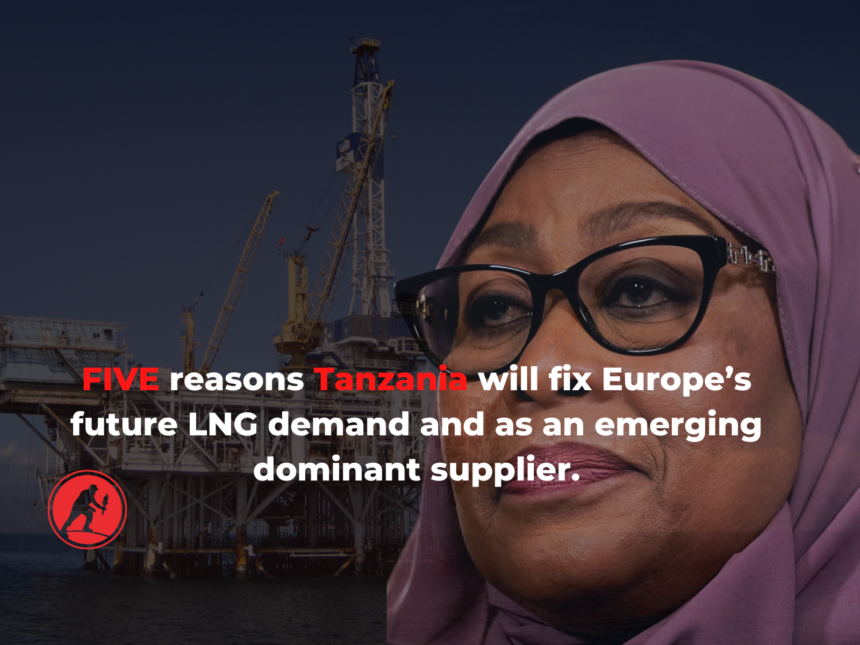Russia’s invasion of Ukraine has forced Europe to seek other options for their energy supply and cut their dependence on Russia. Looking for substitutes for Russia’s gas, the EU has turned its eyes to Africa’s most untapped gas potential.
There are multiple LNG gas producers in Africa that the EU has been importing gas from and other sources from which the EU intends to import in the future.
Tanzania is one of the emerging markets in Africa for the EU LNG market, with an estimated reserve of 57 trillion cubic feet. Africa exports only 18% of LNG to the European Market, with Algeria being the biggest exporter.
The large-scale discovery of LNG in Tanzania places Tanzania in a position to conquer the EU LNG market. Currently, the EU LNG market is predominantly supplied by Nigeria, and Algeria, with a smaller volume for Egypt and a fractional from Equatorial Guinea.
Despite Tanzania’s novice in the LNG business, it is strategically positioned to dominate the future EU LNG market due to some factors.
First: Tanzania’s LNG gas has been discovered to be sweet, which means it has concentrations of hydrogen sulfide (H2S) and carbon dioxide (CO2) that do not require (or have already had) acid gas treatment to meet pipeline corrosion-prevention specifications for transmission and distribution. Hence, cheap option for processing and distribution.
Second: as the world embarks to clean energy, LNG is the cleanest fossil fuel. In the context of the current energy transition sought by the European Commission, it represents an excellent alternative to reduce greenhouse gas emissions and help combat global warming.
Third: Asian markets (India, China, Korea and Japan) offer the highest gas price, accounting for over 70% of new demand. Tanzania’s proximity to the said markets puts its gas at an advantage against competitors.
Fouth: Algeria is Africa’s leading exporter of LNG to the EU. Unfortunately, Algeria’s LNG supply to the EU may plummet as its production capacity shrinks and become no quick fix to Europe Demand.
However, according to Alice Gower, director of geopolitics and security at London-based think tank Azure Strategy, Algeria’s reserves are not developed.
“Earlier this year, Algeria’s state-owned oil and gas group Sonatrach announced a [$40 billion, €36 billion] major investment package for five years, but that doesn’t mean Algeria can step in right now in the short term,” Gower told DW.
With Tanzania’s 57.7 trillion cubic feet of LNG, it can serve as the future and sustainable supplier of LNG to Europe and Asian huge markets.
Fifth: Egypt and Libya are not reliable sources of LNG. According to Gower, “Currently, Egypt is also running out of LNG export capacity,”. As for Libya, According to the statistics portal statista.com, Libya’s natural gas reserves in 2020 amounted to around 1.4 billion cubic meters.
However, the country is so politically divided that it does not appear on the list of countries exporting to Europe. Furthermore, the Libyan infrastructure is insufficient to boost exports, let alone receive the payments. These factors are significant advantages to Tanzania’s EU and Asia LNG supply dominance.
If the $31B mega LNG project completes in 2028, Tanzania’s economy will completely transform. At the signing event of the initial Host Government Agreements (HGAs) between Tanzania, Shell and Equinor, the Minister for Energy of Tanzania, Hon January Makamba, said, “This project will transform the entire economy of the country via, among other means, gas-based industrialisation as well as penetrating the global market.
Generally, President Samia’s policy provides a safe environment for investors. Tanzania’s economy is projected to grow stronger with an influx of investors in the same field of oil and gas and other lucrative investments like mining and agriculture.


